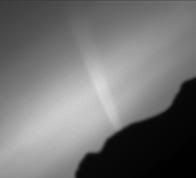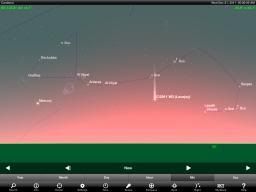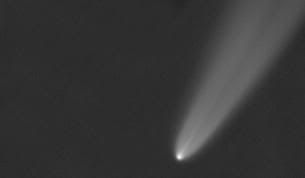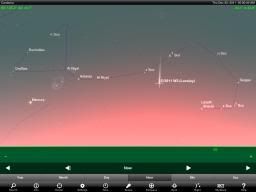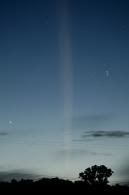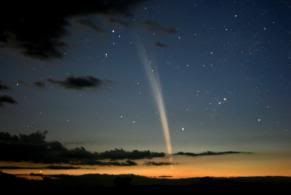http://sungrazer.nrl.navy.mil/index.php?p=.../birthday_comet
Possible very bright sungrazing comet coming mid December - Comet Lovejoy C/2011 W3 (Lovejoy)
Information in the link above.
Full Version: The Great Christmas Comet of 2011
And check out the SOHO Movie Theater! Choose LASCO C3 and the latest 20 or so images.
http://sohodata.nascom.nasa.gov/cgi-bin/soho_movie_theater
http://sohodata.nascom.nasa.gov/cgi-bin/soho_movie_theater
Spaceweather
COMET LOVEJOY UPDATE: Matthew Knight of the Lowell Observatory and JHU-APL reports: "As of 16:30 UT on Dec. 15th, Comet Lovejoy has reached magnitude -3, possibly brighter. It is starting to saturate SOHO images even with narrow filters and shorter than normal exposure times." The comet is now brighter than Jupiter, but not quite as bright as Venus. If these developments continue apace, Comet Lovejoy could become visible to the naked eye in broad daylight before the end of Dec. 15th.
COMET LOVEJOY UPDATE: Matthew Knight of the Lowell Observatory and JHU-APL reports: "As of 16:30 UT on Dec. 15th, Comet Lovejoy has reached magnitude -3, possibly brighter. It is starting to saturate SOHO images even with narrow filters and shorter than normal exposure times." The comet is now brighter than Jupiter, but not quite as bright as Venus. If these developments continue apace, Comet Lovejoy could become visible to the naked eye in broad daylight before the end of Dec. 15th.
Same here. Right now it's overcast from horizon to horizon where I am. 
Here is another video:
http://sdoisgo.blogspot.com/2011/12/phoeni...et-emerges.html
I should add that the comet may look faint in these videos, but the cameras are optimized to stare at the surface of the sun. The fact that the comet is visible at all indicates its tremendous brightness.
http://sdoisgo.blogspot.com/2011/12/phoeni...et-emerges.html
I should add that the comet may look faint in these videos, but the cameras are optimized to stare at the surface of the sun. The fact that the comet is visible at all indicates its tremendous brightness.
That's one tough cookie....
Any estimate for how close it got (in terms of solar radii)?
Any estimate for how close it got (in terms of solar radii)?
140,000 km (1.2 solar radii) above the surface
Seems to have left it's tail behind. 
That tail was so OUT it's growing itself new HOT tail.
http://lasco-www.nrl.navy.mil/javagif/gifs...216_1530_c3.gif
It is still very soon, but it appears that Comet Lovejoy is actually brighter than it was at the same distance from the Sun on the way in, and continues to brighten. (This is not a total surprise -- historically, close sun-grazers have tended to be more spectacular after perihelion than before, provided they survive it.) It could end up being a brilliant comet in the southern hemisphere in the coming days, once it moves a bit further from the Sun's glare.
Quicktime movie
(The nucleus's brightness can be very crudely estimated from the size of the white oversaturation bars extending from the nucleus. They are already longer than any seen by this camera on the inbound trajectory.)
Quicktime movie
(The nucleus's brightness can be very crudely estimated from the size of the white oversaturation bars extending from the nucleus. They are already longer than any seen by this camera on the inbound trajectory.)
The Ion tail has reappeared too.
Another movie:
SOHO LASCO C3
This site only shows the last 3 days of observation, so it's fine for the next day or so, but after that it will be less useful. But right now, it's spectacular!
SOHO LASCO C3
This site only shows the last 3 days of observation, so it's fine for the next day or so, but after that it will be less useful. But right now, it's spectacular!
The next few days may prove interesting...and spectacular for those south of the Equator.
And check out the SOHO Movie Theater! Choose LASCO C3 and the latest 20 or so images.
http://sohodata.nascom.nasa.gov/cgi-bin/soho_movie_theater
You can trace the entire mind-blowing sequence from entrance to exit by selecting 2011-12-15 as the start date and 2011-12-17 as the end date.http://sohodata.nascom.nasa.gov/cgi-bin/soho_movie_theater
Visual sightings starting to come in now.
Why is the view better from south of the Equater? Unless you are above the artic circle...if you can see the sun, you can see the comet?
Comet Lovejoy is no longer a daylight comet, so darkish skies are needed to see it with the unaided eye.
Basically, the orbit of this comet appears from Earth at about a 45 degree angle from the ecliptic towards the south. This means that at mid-southern latitudes, the orbit takes the comet almost directly 'above' the sun at sunrise, so that it will be visible (in the coming weeks) well before sunrise, in fairly dark skies. Therefore the contrast of the comet against the sky will be very good, and its tail will be quite visible (and indications are that the tail will become quite lengthy in the coming weeks).
On the other hand, at mid-northern latitudes the comet will be moving away from the sun in a direction almost parallel with the horizon at sunrise, so it will not even appear above the horizon until the sun is nearly rising (and turning the sky very bright), and remain lost in the near-horizon haze until full daylight. The contrast of the comet against the sky will be far worse than from the mid-southern latitudes, and it is likely that it will not even be visible to the naked eye at all, unlike the situation from the mid-southern latitudes where it is expected to be quite prominent in the pre-sunrise sky.
So we have had two Great Comets in a row (McNaught and now with any luck Lovejoy) best seen from the mid-southern latitudes, and poorly visible from the mid-northern hemisphere. Oh well, those are the breaks.
Basically, the orbit of this comet appears from Earth at about a 45 degree angle from the ecliptic towards the south. This means that at mid-southern latitudes, the orbit takes the comet almost directly 'above' the sun at sunrise, so that it will be visible (in the coming weeks) well before sunrise, in fairly dark skies. Therefore the contrast of the comet against the sky will be very good, and its tail will be quite visible (and indications are that the tail will become quite lengthy in the coming weeks).
On the other hand, at mid-northern latitudes the comet will be moving away from the sun in a direction almost parallel with the horizon at sunrise, so it will not even appear above the horizon until the sun is nearly rising (and turning the sky very bright), and remain lost in the near-horizon haze until full daylight. The contrast of the comet against the sky will be far worse than from the mid-southern latitudes, and it is likely that it will not even be visible to the naked eye at all, unlike the situation from the mid-southern latitudes where it is expected to be quite prominent in the pre-sunrise sky.
So we have had two Great Comets in a row (McNaught and now with any luck Lovejoy) best seen from the mid-southern latitudes, and poorly visible from the mid-northern hemisphere. Oh well, those are the breaks.
Thanks Mongo, great explanation!
Our friends took image from Argentina today morning.

http://www.kommet.cz/
And here's my imagination of comet's path in LASCO C3..

What an exciting weekend.

http://www.kommet.cz/
And here's my imagination of comet's path in LASCO C3..

What an exciting weekend.
This was posted today by highly respected astronomer John Bortle on the comets-ml mailing list:
QUOTE
Based on the brightness estimates from early this morning, reported here on comets-ml, it would tentatively seem that comet 2011 W3 is currently only slightly fainter than was Comet Ikeya-Seki at about the same interval post-T and holding its newfound intrinsic brightness. If this is anywhere near correct and that the tail development evident from spacecraft images is at least fairly representative of what might be seen visually, then observers should begin seriously searching for the comet's bright tail projecting up out of the morning twilight beginning at dawn tomorrow.
The tails of some of the major sungrazing comets have been extraordinarily bright. So much so, in fact, that even their exact terminus, usually a vague and extremely ill-defined feature for more typical bright comets, can be clearly evident to the unaided eye. In the case of the Great March Comet of 1843, the Great September Comet of 1882 and 1965's Comet Ikeya-Seki, the tails appeared rather like segments of a bright searchlight beam, so high in their surface brightness that their total length was distinctly obvious to most observers.
Comet Lovejoy's apparition has been so bizarre up to this point that it is truly difficult to anticipate just what might happen next. Even more hazardous would be to attempt to accurately predict the exact sort of tail it will unfurl in the morning sky. However...in my opinion the potential is there for something quite unusual, perhaps even extraordinary, to present itself, particularly by virtue of the current geometry between the comet and Earth, as it presents the most favorable circumstances possible for observing the tail of a Kreutz sungrazing group comet.
I personally await with great anticipation the first reports of Comet Lovejoy's tail as the comet exits the twilight and begins to traverse the morning skies of the Southern Hemisphere. Please...be complete, accurate and as detailed as possible in describing what you see, the coming event may prove historic.
J.Bortle
The tails of some of the major sungrazing comets have been extraordinarily bright. So much so, in fact, that even their exact terminus, usually a vague and extremely ill-defined feature for more typical bright comets, can be clearly evident to the unaided eye. In the case of the Great March Comet of 1843, the Great September Comet of 1882 and 1965's Comet Ikeya-Seki, the tails appeared rather like segments of a bright searchlight beam, so high in their surface brightness that their total length was distinctly obvious to most observers.
Comet Lovejoy's apparition has been so bizarre up to this point that it is truly difficult to anticipate just what might happen next. Even more hazardous would be to attempt to accurately predict the exact sort of tail it will unfurl in the morning sky. However...in my opinion the potential is there for something quite unusual, perhaps even extraordinary, to present itself, particularly by virtue of the current geometry between the comet and Earth, as it presents the most favorable circumstances possible for observing the tail of a Kreutz sungrazing group comet.
I personally await with great anticipation the first reports of Comet Lovejoy's tail as the comet exits the twilight and begins to traverse the morning skies of the Southern Hemisphere. Please...be complete, accurate and as detailed as possible in describing what you see, the coming event may prove historic.
J.Bortle
Those are some strong words. Wow.
Wow.
Ok, now I really am officially northern hemisphere hacked off. First McNaught dazzles southern hemisphere observers only, now Lovejoy...


Ok, now I really am officially northern hemisphere hacked off. First McNaught dazzles southern hemisphere observers only, now Lovejoy...
Now, now, Stu...we had Hale-Bopp! 
But, yeah, I feel some hemispherical comet-envy myself here. If I had the money & time my butt would be on the next flight to the most southerly location with good weather predicitions possible.
But, yeah, I feel some hemispherical comet-envy myself here. If I had the money & time my butt would be on the next flight to the most southerly location with good weather predicitions possible.
Wow.
Ok, now I really am officially northern hemisphere hacked off. First McNaught dazzles southern hemisphere observers only, now Lovejoy...


Ok, now I really am officially northern hemisphere hacked off. First McNaught dazzles southern hemisphere observers only, now Lovejoy...
Just for the record, there were things of interest to observe with McNaught from 40N latitude. Just around perihelion time, it actually was to the NE of the sun and best visible from northern latitudes at mag -5 to -6. I saw it in broad daylight in binoculars, and naked eye just after sunset. Furthermore, the ghostly outer rays of the tail were pointing straight up from the western horizon after evening twilight ended a few days later.
Now with Lovejoy, it was spotted in broad daylight from France - of course a mid-northern latitude - image can be seen at this link:
http://spaceweather.com/submissions/large_..._1324194382.jpg
Really would be interesting to plot this comet's magnitude vs solar elongation in comparison to McNaught and Ikeya-Seki.
Steve
Report of a daylight sighting of Comet Lovejoy on comets-ml mailing list:
QUOTE
Daylight Comet!
by Rick Baldridge
The amazing happened. Comet Lovejoy (C/2011 W3) survived what was thought to be a suicide plunge into the solar corona, passing only 78,800 miles from the surface of the Sun on December 16th – not quite 1/10th a solar diameter! Surprisingly, the comet reappeared on SOHO LASCO images barely 1 hour after perihelion passage, prompting Brian Day of NASA/Ames and I to attempt a daylight observation.
We ran up to Foothill College Observatory (Los Altos Hills, CA) at lunch time on Dec 16th and opened up the dome. I quickly made a 3" aperture off-axis mask for the Meade 16" Schmidt scope, which allowed me to use the dome shutter as a glare shield, keeping direct sunlight out of the telescope tube assembly. Comet Lovejoy was barely 4° west of the sun during the attempted observation.
Finding Venus first to focus on, I used coordinates from JPL HORIZONS to center the `scope on the comet's expected position. After looking through a 127x eyepiece for a few moments – THERE IT WAS! A very star-like nucleus with a faint but obvious fan shaped glow streaming away from it. The fan was maybe 20 arc-seconds long. A very rough guess was the nucleus was magnitude -1, based on my impression of the appearance of Mercury years ago at a similar solar elongation. This initial sighting came at 11:48am PST (Dec 16th at 19:48UT)
Brian Day was quickly called, who had just driven into the Observatory parking lot. He came up, took one look in the eyepiece, and after adapting to the brightness of the background sky, exclaimed, "DAMN! There it is!"
We were ecstatic! Seeing a daylight comet is an extremely rare thing, and so close to the sun – only 4 degrees. Truly amazing!
Unfortunately, Brian and I did not have our DSLRs to attempt taking a photo. We tried our cell phone cameras, holding the lens up to the eyepiece using afocal projection, but to no avail.
It was an experience we will never forget!
by Rick Baldridge
The amazing happened. Comet Lovejoy (C/2011 W3) survived what was thought to be a suicide plunge into the solar corona, passing only 78,800 miles from the surface of the Sun on December 16th – not quite 1/10th a solar diameter! Surprisingly, the comet reappeared on SOHO LASCO images barely 1 hour after perihelion passage, prompting Brian Day of NASA/Ames and I to attempt a daylight observation.
We ran up to Foothill College Observatory (Los Altos Hills, CA) at lunch time on Dec 16th and opened up the dome. I quickly made a 3" aperture off-axis mask for the Meade 16" Schmidt scope, which allowed me to use the dome shutter as a glare shield, keeping direct sunlight out of the telescope tube assembly. Comet Lovejoy was barely 4° west of the sun during the attempted observation.
Finding Venus first to focus on, I used coordinates from JPL HORIZONS to center the `scope on the comet's expected position. After looking through a 127x eyepiece for a few moments – THERE IT WAS! A very star-like nucleus with a faint but obvious fan shaped glow streaming away from it. The fan was maybe 20 arc-seconds long. A very rough guess was the nucleus was magnitude -1, based on my impression of the appearance of Mercury years ago at a similar solar elongation. This initial sighting came at 11:48am PST (Dec 16th at 19:48UT)
Brian Day was quickly called, who had just driven into the Observatory parking lot. He came up, took one look in the eyepiece, and after adapting to the brightness of the background sky, exclaimed, "DAMN! There it is!"
We were ecstatic! Seeing a daylight comet is an extremely rare thing, and so close to the sun – only 4 degrees. Truly amazing!
Unfortunately, Brian and I did not have our DSLRs to attempt taking a photo. We tried our cell phone cameras, holding the lens up to the eyepiece using afocal projection, but to no avail.
It was an experience we will never forget!
Wow.
Mongo, please keep feeding salient info like this at your discretion. I think that there is a SLIGHT chance that this thing might be visible to unskilled observers over the next few days, and anything we can do to promulgate awareness would be very useful. Thanks!!!
Mongo, please keep feeding salient info like this at your discretion. I think that there is a SLIGHT chance that this thing might be visible to unskilled observers over the next few days, and anything we can do to promulgate awareness would be very useful. Thanks!!!
For those readers who are in the southern hemisphere, here is a finder chart for Comet Lovejoy from latitude 35 degrees south, for this Tuesday morning before sunrise:
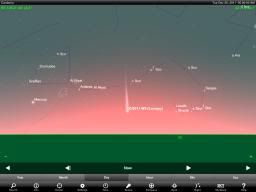
This is from Where to look for Comet 2011 W3 (Lovejoy) Tuesday morning

This is from Where to look for Comet 2011 W3 (Lovejoy) Tuesday morning
Magnificent!!!
Amazing images, it's unbelievable, that this little comet survived flyby so close to Sun! 
Impressive it withstood the tidal effects too.
Latest today from comet-ml mailing list:
The comet, as expected, is getting more prominent as it starts to move out of the morning twilight.
The thread title is "The SOHO Birthday Comet", but I think a better name would be "The Great Christmas Comet of 2011", since with the new moon on December 24th, viewing conditions should greatly improve just in time for Christmas. Not to mention that by then it should be well clear of the morning twilight, and significantly closer to Earth with a better viewing geometry.
QUOTE
Hi all,
I observed Lovejoy this morning from Woolbrook, NSW, i am so excited, at 4am AEDST i took an image of the Eastern horizon and upon looking at the image i noticed a thin "search beam" like extension pointing up from the SE, tilted a little to the North. I looked with my naked eye and saw what appeared to be headlights of a car near my horizon but it didn't seems to move, long story short....the tail i measured over the next 50 mins was nearly 15 degrees long and in moonlight!
Clouds not long intervened at dawn and i tried for the comet head but saw nothing in my 10" dob.
Images to follow!
Cheers,
Chris Wyatt
Walcha, NSW
Australia
I observed Lovejoy this morning from Woolbrook, NSW, i am so excited, at 4am AEDST i took an image of the Eastern horizon and upon looking at the image i noticed a thin "search beam" like extension pointing up from the SE, tilted a little to the North. I looked with my naked eye and saw what appeared to be headlights of a car near my horizon but it didn't seems to move, long story short....the tail i measured over the next 50 mins was nearly 15 degrees long and in moonlight!
Clouds not long intervened at dawn and i tried for the comet head but saw nothing in my 10" dob.
Images to follow!
Cheers,
Chris Wyatt
Walcha, NSW
Australia
The comet, as expected, is getting more prominent as it starts to move out of the morning twilight.
The thread title is "The SOHO Birthday Comet", but I think a better name would be "The Great Christmas Comet of 2011", since with the new moon on December 24th, viewing conditions should greatly improve just in time for Christmas. Not to mention that by then it should be well clear of the morning twilight, and significantly closer to Earth with a better viewing geometry.
In moonlight, no less.
Good grief.
Good grief.
The thread title is "The SOHO Birthday Comet", but I think a better name would be "The Great Christmas Comet of 2011"
I agree, I added the "2011 W3 (Lovejoy)" subheading earlier today to help identify the thread and have now changed the main title to your suggestion.
Oh-oh. That title change may have been premature. It appears that the comet nucleus may have broken up within the past few hours.
From comet-ml post #18949:
From comet-ml post #18950 by Gary Kronk:
From comet-ml post #18952:
From comet-ml post # 18955 by Gary Kronk:
From comet-ml post #18949:
QUOTE
Comets gets weaker, today pictures in V-filtered exposures giving at 20.34 UT: ~3.5 mag (comparsion tar TYC 7364-2287-1 ).
Filtered images from FRAM this morning (average of best pictures).
http://www.kommet.cz/datas/users/1220average_r_dbe_1.png
http://www.kommet.cz/datas/users/1220average_v_dbe_1.png
Filtered images from FRAM this morning (average of best pictures).
http://www.kommet.cz/datas/users/1220average_r_dbe_1.png
http://www.kommet.cz/datas/users/1220average_v_dbe_1.png
From comet-ml post #18950 by Gary Kronk:
QUOTE
These are very interesting images. Either the nucleus and bright tail ray have been merged during the processing of these images or the distinct nucleus has broke up...appearing like a bar. This latter description has been given before when nuclei have been reported to break up.
From comet-ml post #18952:
QUOTE
This animation from Karl shows the comet fading in STEREO HI1A. A dust tail wedge is getting longer and broader, sits on top of original dust tail. There is a small recurring spike tail near and below the head that seems to be from a rotating nucleus.
http://sungrazer.nrl.navy.mil/index.php?p=...18\_19.gif
Where would all the new dust be coming from? There rate of new dust tail extension is occurring rapidly. Possible breakup starting?
http://sungrazer.nrl.navy.mil/index.php?p=...18\_19.gif
Where would all the new dust be coming from? There rate of new dust tail extension is occurring rapidly. Possible breakup starting?
From comet-ml post # 18955 by Gary Kronk:
QUOTE
The sudden appearance of bright rays are not uncommon when it comes to a comet breaking up. Check out the following link on my Cometography web site that discusses comet C/1999 S4 (LINEAR):
http://cometography.com/lcomets/1999s4.html
If you scroll down a bit, you will see two pictures from 1999 July 21, that show a bright tail ray. Within days the comet was unmistakably breaking up.
By the way the link to my comet Lovejoy web page is as follows:
http://cometography.com/lcomets/2011W3.html
Sincerely,
Gary
http://cometography.com/lcomets/1999s4.html
If you scroll down a bit, you will see two pictures from 1999 July 21, that show a bright tail ray. Within days the comet was unmistakably breaking up.
By the way the link to my comet Lovejoy web page is as follows:
http://cometography.com/lcomets/2011W3.html
Sincerely,
Gary
A photo from this post:
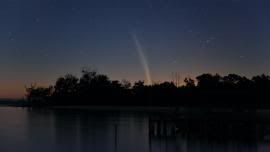
QUOTE
After reading Ian Cooper's post I decided to drive south to the Mandurah Esturary around 2 am for a look. Light pollution is pretty low down there. I took 2 cameras, 1 for timelapsing and the other stills. I started taking images around 2:50 WST. At around 3:10 the first hint of tail appeared above the trees and by 3:15 I could see it visually. It stayed in clear view (non averted vision) from then until around 4:10 (deep twilight). An awesome sight. [...] If you're lucky enough to have clear skies tomorrow, I urge you to go out before the onset of astronomical twilight. If the comet is anything like it was this morning you won't be disappointed.

From comet-ml post #18958:
In response to this, John Bortle wrote in comet-ml post #18961:
QUOTE
Hi all,
When I first looked out this morning (from Cowra in central NSW) and saw the layers of high and middle-level cloud, I almost went back to bed. But after a few minutes deciding, I set up the 25x100 binocular telescope and started to sweep along the horizon which, surprisingly, was clear for the first two or three degrees. At 4.20 local summer time (1720 UT) I noticed something like a distant searchlight beam rising over the slope of a small hill which sports the rather grandiose name of "Porter's Mount". With the sky becoming bright, I could see a clear feature on the local horizon (a tree about two thirds of the way up the grassland slope of Porter's Mount) near where the beam emerged and, finding this without the telescope, I could then see about 2 - 3 degrees of tail rising up to a bank of heavy cloud. The tail must have been quite intense to be seen in such a bright sky and, from the calculated position of the head, at least 7 - 8 degrees long (although most of this was not seen. Neither was the head as the sky had become very bright by the time it would have cleared Porter's Mount).
On a slightly different topic, as one of the few Ikeya-Seki veterans in this group, it is probably timely to sound a warning not to give up on this comet because of the degree of fading that has obviously taken place. Back in 1965, the arrival of I-S at perihelion was surrounded by a lot of media hype. Predictions that a comet brighter than the Moon was coming, while they turned out to be technically true, failed to make clear that the comet would be only a few arcminutes from the Sun's limb at that time and would fade very rapidly afterwards. Of course, the general public missed much of the display at perihelion and dismissed the comet as a dud. On the day of perihelion, Fred Whipple called it "a scientist's comet"; one that was great for astronomers but a disappointment for the public. Unfortunately, the media dropped the subject (by and large) and when the "public" show occurred over a week later, only those who normally rose before dawn for work or other purposes saw it.
My first couple of views post perihelion were not all that exciting. High cloud always seemed to shroud the eastern horizon and by the time the comet cleared this, the sky was very bright and the comet looked washed out with only a small diffuse spot of a coma and a fading tail. Then, exactly 10 days after perihelion, there was a morning of exceptional clarity and by that time the comet was far enough from the Sun to be rising in a dark sky. The sight was magnificent. In the dark sky, the coma appeared brighter than the earlier twilight views and looked small and dense. As for the tail, this appeared (as John Bortle has written on several occasions to this group) "solid", not diaphanous like the tail of a normal comet. And there was little "normal" about Ikeya-Seki! Today, we would probably think of laser beams or Star-Wars light sabres ... but this was back in 1965!!
Now, I am certainly not saying that W3 will become as remotely spectacular as I-S, but the lessons of 1965 are worth noting. The comet may become faint, but the tail may well retain relatively high surface brightness for quite some time and be impressive in coming days as it pulls out from the twilight (and moonlight). Don't dismiss this comet just yet! There may still be surprises in store.
David
When I first looked out this morning (from Cowra in central NSW) and saw the layers of high and middle-level cloud, I almost went back to bed. But after a few minutes deciding, I set up the 25x100 binocular telescope and started to sweep along the horizon which, surprisingly, was clear for the first two or three degrees. At 4.20 local summer time (1720 UT) I noticed something like a distant searchlight beam rising over the slope of a small hill which sports the rather grandiose name of "Porter's Mount". With the sky becoming bright, I could see a clear feature on the local horizon (a tree about two thirds of the way up the grassland slope of Porter's Mount) near where the beam emerged and, finding this without the telescope, I could then see about 2 - 3 degrees of tail rising up to a bank of heavy cloud. The tail must have been quite intense to be seen in such a bright sky and, from the calculated position of the head, at least 7 - 8 degrees long (although most of this was not seen. Neither was the head as the sky had become very bright by the time it would have cleared Porter's Mount).
On a slightly different topic, as one of the few Ikeya-Seki veterans in this group, it is probably timely to sound a warning not to give up on this comet because of the degree of fading that has obviously taken place. Back in 1965, the arrival of I-S at perihelion was surrounded by a lot of media hype. Predictions that a comet brighter than the Moon was coming, while they turned out to be technically true, failed to make clear that the comet would be only a few arcminutes from the Sun's limb at that time and would fade very rapidly afterwards. Of course, the general public missed much of the display at perihelion and dismissed the comet as a dud. On the day of perihelion, Fred Whipple called it "a scientist's comet"; one that was great for astronomers but a disappointment for the public. Unfortunately, the media dropped the subject (by and large) and when the "public" show occurred over a week later, only those who normally rose before dawn for work or other purposes saw it.
My first couple of views post perihelion were not all that exciting. High cloud always seemed to shroud the eastern horizon and by the time the comet cleared this, the sky was very bright and the comet looked washed out with only a small diffuse spot of a coma and a fading tail. Then, exactly 10 days after perihelion, there was a morning of exceptional clarity and by that time the comet was far enough from the Sun to be rising in a dark sky. The sight was magnificent. In the dark sky, the coma appeared brighter than the earlier twilight views and looked small and dense. As for the tail, this appeared (as John Bortle has written on several occasions to this group) "solid", not diaphanous like the tail of a normal comet. And there was little "normal" about Ikeya-Seki! Today, we would probably think of laser beams or Star-Wars light sabres ... but this was back in 1965!!
Now, I am certainly not saying that W3 will become as remotely spectacular as I-S, but the lessons of 1965 are worth noting. The comet may become faint, but the tail may well retain relatively high surface brightness for quite some time and be impressive in coming days as it pulls out from the twilight (and moonlight). Don't dismiss this comet just yet! There may still be surprises in store.
David
In response to this, John Bortle wrote in comet-ml post #18961:
QUOTE
David is absolutely correct. I anticipate that the spectacle is only likely to grow better with time as the tail moves out of the morning twilight. Keep in mind that the brightness of a sungrazer's dust tail seems to fade much more slowly than does that of the coma, following closer to a rate dictated by the inverse square law. Likewise, Comet Lovejoy's tail is more-or-less still approaching Earth as the comet retreats from the Sun, slowing the fading process even further.
Go back and consult some of my earlier posts concerning the development of Comet Ikeya-Seki's post-T dust tail. Such may well foreshadow the sort of evolutionary path that the tail of Comet Lovejoy may see in days to come on a somewhat more modest scale.
Folks, be assured that the show isn't over yet by any means.
J.Bortle
Go back and consult some of my earlier posts concerning the development of Comet Ikeya-Seki's post-T dust tail. Such may well foreshadow the sort of evolutionary path that the tail of Comet Lovejoy may see in days to come on a somewhat more modest scale.
Folks, be assured that the show isn't over yet by any means.
J.Bortle
From comet-ml post #18977:
QUOTE
Hi All,
I have to eat my words to friends about this comet. Looks just like Ikeya-Seki in 1965. A really beautiful Xmas present.
I got a series of images this morning but have no website, so one of the better ones appears in the nzastronomers site.
I estimated the visible tail length at 18 degrees, and the head was still out of sight below the local horizon here in New Plymouth, New Zealand.
I have to eat my words to friends about this comet. Looks just like Ikeya-Seki in 1965. A really beautiful Xmas present.
I got a series of images this morning but have no website, so one of the better ones appears in the nzastronomers site.
I estimated the visible tail length at 18 degrees, and the head was still out of sight below the local horizon here in New Plymouth, New Zealand.
From comet-ml post #18990 by Robert McNaught:
QUOTE
After several nights or mornings of poor weather, and the prospect of these continuing here at Siding Spring, I decided it was time to move. This morning gave an opportunity to find clear sky about 20km to the west, away from the mountain fog and orographic cloud. And boy, was it worth it! This is a most beautiful comet.
The tail was very obvious to the naked eye, rather brighter than the Milky Way in Circinus, Norma and Ara but not quite as bright as in Crux and Carina. The split between the dust and gas tails was clearly evident to the naked eye.
10x50 binoculars didn't show much more tail length, but structure was present, especially the "spine" along the southern edge of the dust tail, continuing past the bifurcation of the dust and gas tails. The end of the dust tail fades off very rapidly and naked eye, 10x50B and various photos have the tail reaching RA 15h54m Dec -40.0 (2000) The ephemeris position at that time was RA 17h02.3 Dec -34d56' (2000) giving a dust tail of 14.3 deg. The gas tail is perhaps 1 deg longer but fades away much more gradually and thus has a less well defined end point. The edges of the dust and gas tail are very sharply defined.
The tail brightness from the bifurcation towards the head was quite uniform, but as twilight progressed, the tail near the head became lost in the twilight and I didn't see the head visually or record it on photos. This is not a strong conclusion, as I had to move to a better location to find a lower horizon and the sky brightness probably beat me. I'd be reasonably confident that from tomorrow onwards I'll be able to make some meaningful statement about the visibility of the head.
To place this comet in the pantheon of modern comets (essentially subjective), I'd put it in the class of Hale-Bopp, Hyakutake and Bennett with this morning's view.
I'll try to get some photos up later today.
Cheers, Rob
The tail was very obvious to the naked eye, rather brighter than the Milky Way in Circinus, Norma and Ara but not quite as bright as in Crux and Carina. The split between the dust and gas tails was clearly evident to the naked eye.
10x50 binoculars didn't show much more tail length, but structure was present, especially the "spine" along the southern edge of the dust tail, continuing past the bifurcation of the dust and gas tails. The end of the dust tail fades off very rapidly and naked eye, 10x50B and various photos have the tail reaching RA 15h54m Dec -40.0 (2000) The ephemeris position at that time was RA 17h02.3 Dec -34d56' (2000) giving a dust tail of 14.3 deg. The gas tail is perhaps 1 deg longer but fades away much more gradually and thus has a less well defined end point. The edges of the dust and gas tail are very sharply defined.
The tail brightness from the bifurcation towards the head was quite uniform, but as twilight progressed, the tail near the head became lost in the twilight and I didn't see the head visually or record it on photos. This is not a strong conclusion, as I had to move to a better location to find a lower horizon and the sky brightness probably beat me. I'd be reasonably confident that from tomorrow onwards I'll be able to make some meaningful statement about the visibility of the head.
To place this comet in the pantheon of modern comets (essentially subjective), I'd put it in the class of Hale-Bopp, Hyakutake and Bennett with this morning's view.
I'll try to get some photos up later today.
Cheers, Rob
This is a "lo-fi" version of our main content. To view the full version with more information, formatting and images, please click here.

